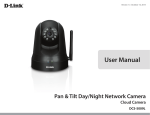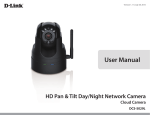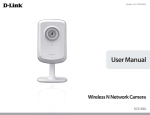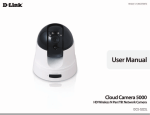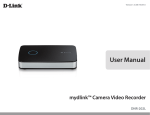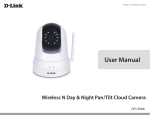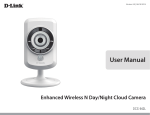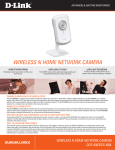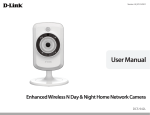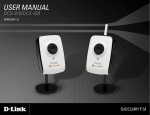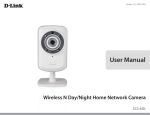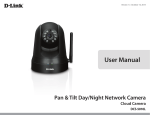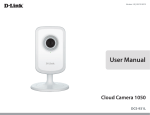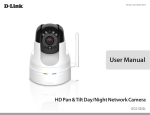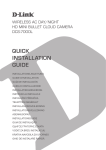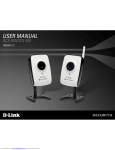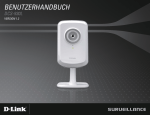Download User Manual - Cctv Security System
Transcript
Version 2.0 | 08/20/2014 User Manual Day Wi-Fi Network Camera Cloud Camera DCS-930L Preface D-Link reserves the right to revise this publication and to make changes in the content hereof without obligation to notify any person or organization of such revisions or changes. Information in this document may become obsolete as our services and websites develop and change. Refer to the www.mydlink.com for the most current information. Manual Revision Revision Date 1.0 July 19, 2010 1.1 December 7, 2011 2.0 August 20, 2014 Description Revision A1 with firmware version 1.0 Updated with minor fixes Revision B1 with firmware version 1.0 Trademarks D-Link and the D-Link logo are trademarks or registered trademarks of D-Link. All other third-party marks mentioned herein may be trademarks of their respective owners. © 2014 by D-Link. All Rights Reserved. Preface Safety Instructions Follow the safety guidelines listed below to ensure your own personal safety and to help protect your product from potential damage. If any of the following conditions occur, unplug the product from the electrical outlet and either replace the part that is damaged, or contact the place of purchase: • The power cable, extension cable, or plug is damaged. • An object has fallen into the product. • The product has been exposed to water. • The product has been dropped or damaged. • The product does not operate correctly when you follow the operating instructions. Follow the safety guidelines below: •Do not spill food or liquids on product, and never operate the product in a wet environment. If the product gets wet, see the appropriate section in your troubleshooting guide. • Operate the product only from the type of external power source indicated on the electrical ratings label. If you are not sure of the type of power source required, consult your local power company. •Use only the power adapter that came with the product. Using another adapter, not recommended by the manufacturer, may damage the product and invalidate the warranty. • To help prevent an electric shock, plug the product into properly grounded electrical outlets. •Observe power strip ratings. Make sure that the total ampere rating of all products plugged into the power strip does not exceed 80 percent of the ampere ratings limit for the power strip. •To help protect your product from sudden, transient increases and decreases in electrical power, use a surge suppressor, line conditioner, or uninterruptible power supply (UPS). D-Link DCS-930L User Manual 3 Preface • Position product cables and power cables carefully. Route cables so that they cannot be stepped on or tripped over. Be sure that nothing rests on any cables. Do not modify power cables or plugs. Consult a licensed electrician or your power company for site modifications. Always follow your local/national wiring rules. • This product is designed for indoor use only, and must always be positioned where it is not exposed to direct sunlight or strong halogen light. Exposure to direct sunlight or halogen light may cause permanent damage to the image sensor in the product. Warnings • STRANGULATION HAZARD! – Keep cords out of the reach of children. Keep and secure all cords a minimum of three feet away from a crib or other child sleeping area. • This product contains small parts that may cause choking. Keep out of reach of children. • This product is not a toy. Do not allow children to play with it. • The product is designed for Indoor Use Only! • The product should not be used in a location where it could become wet! • Ensure the product is fixed securely otherwise it may fall and cause injury! • This product is NOT intended to replace proper supervision of children. You must check your child’s activity regularly, as this product will not alert parents to activity of children. • Do not use extension cords. Only use the power adapter provided with this product. • Do not use this product near a heat source. THIS DEVICE REQUIRES THIRD-PARTY SERVICES AND PRODUCTS TO ACHIEVE FULL FUNCTIONALITY, INCLUDING BUT NOT LIMITED TO, BROADBAND INTERNET SUBSCRIPTION SERVICES AND PRODUCTS; MOBILE INTERNET SUBSCRIPTION SERVICES, COVERAGE AND PRODUCTS; CAMERA MANAGEMENT SOFTWARE, AND; A NETWORK CONNECTION. D-LINK HAS NO CONTROL OVER SUCH SERVICES AND PRODUCTS AND EXPRESSLY DISCLAIMS ANY AND ALL LIABILITY FOR THE FAILURE OF THE DEVICE OR ANY FEATURE THEREOF RESULTING FROM THE FAILURE OF ANY THIRD-PARTY SERVICE OR PRODUCT. D-Link DCS-930L User Manual 4 Table of Contents Table of Contents Preface................................................................................. 2 Manual Revision............................................................................. 2 Trademarks...................................................................................... 2 Safety Instructions........................................................................ 3 Warnings................................................................................... 4 Product Overview............................................................... 7 Package Contents.......................................................................... 7 Minimum Requirements............................................................. 8 Introduction.................................................................................... 9 Features...........................................................................................10 Hardware Overview....................................................................11 Front View...............................................................................11 Rear View................................................................................12 Installation........................................................................13 Wireless Installation Considerations.....................................14 Zero Configuration Setup.........................................................15 Camera Setup Wizard.................................................................18 Windows Users.....................................................................18 Mac Users...............................................................................19 Manual Installation.....................................................................20 WPS - Push Button Setup..........................................................21 Mounting the Camera...............................................................22 mydlink™...........................................................................23 What is mydlink?..........................................................................24 D-Link DCS-930L User Manual mydlink Apps................................................................................24 Configuration....................................................................25 Accessing the Web Configuration Utility............................25 Live Video.......................................................................................26 Setup................................................................................................26 Internet Connection Setup Wizard................................27 Network Setup......................................................................29 Wireless Setup.......................................................................31 Dynamic DNS .......................................................................32 Image Setup..........................................................................33 Video........................................................................................34 Audio........................................................................................35 Motion Detection................................................................36 Sound Detection..................................................................37 Mail...........................................................................................38 FTP.............................................................................................40 Time and Date.......................................................................42 Maintenance.................................................................................43 Admin......................................................................................43 System.....................................................................................44 Firmware Upgrade...............................................................45 Status...............................................................................................46 Device Info.............................................................................46 Active User.............................................................................47 Configuring the DCS-930L without mydlink.....................48 5 Table of Contents Wireless Security..............................................................54 What is WEP?.................................................................................54 What is WPA?.................................................................................55 Troubleshooting...............................................................56 Wireless Basics..................................................................58 Wireless Modes.............................................................................62 Networking Basics............................................................63 Check your IP address................................................................63 Statically Assign an IP Address...............................................64 Technical Specifications...................................................66 Contacting Technical Support.........................................68 Warranty............................................................................69 Registration......................................................................76 D-Link DCS-930L User Manual 6 Section 1 - Product Overview Product Overview Package Contents DCS-930L Day Wi-Fi Network Cloud Camera Power Adapter Ethernet Cable Wall Mount Kit Quick Install Guide If any of the above items are missing, please contact your reseller. Note: Using a power supply with a different voltage than the one included with your DCS-930L will cause damage and void the warranty for this product. D-Link DCS-930L User Manual 7 Section 1 - Product Overview Minimum Requirements Network Requirements • Wired 10/100 Fast Ethernet or a wireless 802.11g/n wireless network (Wireless N network recommended for optimum performance) Computer with the following: • 1.3 GHz processor or above and at least 128MB RAM • Windows® 8, 7, Vista®, or Mac OS®X (10.6 or higher) Web-based Configuration Utility Requirements Web Browser: • Internet Explorer® 7 or higher • Firefox® • Safari® 6 or higher • Chrome™ Windows® Users: Make sure you have the latest version of Java installed and enabled. Visit www.java.com to download the latest version. Network Device and Service mydlink Requirements D-Link DCS-930L User Manual • A router (D-Link Cloud Router is recommended) • An Internet connection • An e-mail account (required to create a mydlink™ account) • For mydlink and mydlink app requirements refer to: http://www.mydlink.com 8 Section 1 - Product Overview Introduction The DCS-930L Day Wi-Fi Network Camera is a versatile surveillance solution for your home or small office. Unlike a standard webcam, the DCS-930L is a complete system with a built-in CPU and web server that transmits high quality video images. The DCS-930L can be accessed remotely, and controlled from any PC/Notebook over your local network, or through the Internet using a web browser. The simple installation and intuitive web-based interface offer easy integration with your Ethernet/Fast Ethernet or 802.11g/n wireless network. The DCS-930L also comes with remote monitoring and motion/sound detection features for a complete and cost-effective home security solution. D-Link DCS-930L User Manual 9 Section 1 - Product Overview Features Simple to Use The DCS-930L is a stand-alone system with a built-in CPU, requiring no special hardware or software. The DCS-930L supports both ActiveX mode for Internet Explorer® and Java mode for other browsers such as Firefox® and Safari®. Supports a Variety of Platforms Supporting TCP/IP networking, HTTP, and other Internet related protocols. The DCS-930L can also be integrated easily into other Internet/Intranet applications because of its standards-based features. 802.11n Wireless or Ethernet/Fast Ethernet Support The DCS-930L offers wireless 802.11n and Ethernet/Fast Ethernet connectivity, making the camera easy to integrate into your existing network environment. The DCS-930L works with a 10Mbps Ethernet based network or 100Mbps Fast Ethernet based network for traditional wired environments, and works with 802.11n routers or access points for added flexibility. The Site Survey feature allows you to view and connect to any available wireless network. Web Configuration Using a standard Web browser, administrators can configure and manage the network camera directly from its own Web page via Intranet or Internet. This means you can access your DCS-930L anytime, from anywhere. Broad Range of Applications With today’s high-speed Internet services, the DCS-930L provides the ideal solution for delivering live video images over the Intranet and Internet for remote monitoring. It allows remote access using a Web browser for live image viewing, and allows the administrator to manage and control the network camera anytime, from anywhere in the world. Many applications exist, including industrial and public monitoring of homes, offices, banks, hospitals, child-care centers, and amusement parks. Remote Monitoring Utility The D-ViewCam application adds enhanced features and functionality to the DCS-930L, and allows administrators to configure and access the camera from a remote site using the Internet or an intranet. Other features include image monitoring, recording images to a hard drive, viewing up to 32 cameras on one screen, and taking snapshots. D-Link DCS-930L User Manual 10 Section 1 - Product Overview Hardware Overview Front View Camera Lens Microphone Camera Stand D-Link DCS-930L User Manual 11 Section 1 - Product Overview Rear View Power Receptor Ethernet Port Power & Link LED Reset Button WPS LED WPS Button Camera Stand D-Link DCS-930L User Manual 12 Section 2 - Installation Installation There are three ways to set up your camera: Zero Configuration Setup: If you have a mydlink-enabled router (D-Link Cloud Router), this is the easiest way to set up your camera. Refer to “Zero Configuration Setup” on page 15. Camera Setup Wizard: If you do not have a mydlink-enabled router, use the Camera Setup Wizard to guide you through setup and initial configuration of your camera. Refer to “Camera Setup Wizard” on page 18. Manual Hardware Installation: This section shows you how to manually set up your camera, however in order to use the mydlink features of your camera, you should still run the Camera Setup Wizard. Refer to “Manual Installation” on page 20. D-Link DCS-930L User Manual 13 Section 2 - Installation Wireless Installation Considerations The D-Link Wireless Network Camera lets you access your network using a wireless connection from anywhere within the operating range of your wireless network. However, the number, thickness and location of walls, ceilings, or other objects that the wireless signals must pass through, may limit the range. Typical ranges vary depending on the types of materials and background RF (radio frequency) noise in your home or business. The key to maximizing wireless range is to follow these basic guidelines: 1. Minimize the number of walls and ceilings between your adapter and other network devices (such as your network camera) - each wall or ceiling can reduce your adapter’s range from 3-98 feet (1-30 meters). 2. Be aware of the direct line between network devices. A wall that is 1.5 feet thick (0.5 meters), at a 45-degree angle appears to be almost 3 feet (1 meter) thick. At a 2-degree angle, it looks over 46 feet (about 14 meters) thick. Position your devices so that the signal will travel straight through a wall or ceiling (instead of at an angle) for better reception. 3. Building Materials make a difference. A solid metal door or aluminum studs may weaken the wireless signal. Try to position your access points, wireless routers, and other networking devices where the signal passes through drywall or open doorways. Materials and objects such as glass, steel, metal, walls with insulation, water (fish tanks), mirrors, file cabinets, brick, and concrete will degrade your wireless signal. 4. Keep your product at least 3-6 feet or 1-2 meters away from electrical devices or appliances that generate RF noise. 5. If you are using 2.4GHz cordless phones or other radio frequency sources (such as microwave ovens), your wireless connection may degrade dramatically or drop completely. Make sure your 2.4GHz phone base is as far away from your wireless devices as possible. The base transmits a signal even if the phone is not in use. D-Link DCS-930L User Manual 14 Section 2 - Installation Zero Configuration Setup The Zero Configuration Setup will only work with a registered Cloud Router and an active mydlink account. Your Cloud Router will automatically assign your camera’s network settings (both wired and wireless), and add the camera to your mydlink account. This means you can set up your camera by simply plugging it in and connecting it to your router. After the setup is complete, you can remotely access your camera from the website (http://www.mydlink.com). If you do not have a D-Link Cloud Router, skip to the “Camera Setup Wizard” on page 18. Or if you prefer, you can skip to ”Manual Installation” on page 20. To learn more about mydlink, refer to “What is mydlink?” on page 24. Connect the Power Cable and Ethernet Cable Step 1 Attach the power supply to the power receptor located on the back of the DCS-930L and connect it to a wall outlet or power strip. Power is confirmed when the Power LED is lit. Step 2 If using an Ethernet connection, connect the included Ethernet cable to the Ethernet port located on the back of your camera. Plug the other end into an available port on your D-link Cloud Router. Note: If you later decide to use your camera wirelessly, you will be able to remove the cable after Zero Configuration Setup is complete. If you prefer to initiate a wireless connection with your router, you can use WPS (Wi-Fi Protected Setup). Refer to “WPS - Push Button Setup” on page 21. D-Link DCS-930L User Manual 15 Section 2 - Installation Add Your Camera to Your mydlink Account Step 3 From a computer connected to the Internet, open a web browser (e.g., Internet Explorer, Chrome, Firefox, or Safari) and go to http://www.mydlink.com. Sign in to your mydlink account. Step 4 The mydlink page will automatically check for new devices. Once mydlink detects your camera, a notice will appear that says, New device Found! (at the bottom of the screen). Click the notification to continue. D-Link DCS-930L User Manual 16 Section 2 - Installation Step 5 A confirmation request will appear with a summary of the configuration details. Make a note of the details and click Yes to add the camera to your account. Your setup is complete! DCS-930L Step 6 You will see the mydlink Live View for your camera. The screen will look similar to the screen shot on the right. Note: If you used an Ethernet connection and now want to connect your camera to your router wirelessly, you can simply disconnect the Ethernet cable and move the camera to the preferred location. Your router’s wireless settings were automatically transferred to the camera during Zero Configuration Setup, so no further configuration is required. If you are interested in learning about advanced configuration of your camera, you can skip to “Configuration” on page 25. Note: If you notice a white haze when viewing in night vision mode, the night vision light on the camera may be reflecting off a nearby surface. Try repositioning and aiming the camera. D-Link DCS-930L User Manual 17 Section 2 - Installation Camera Setup Wizard If you do not have a D-Link Cloud Router, you can use any Windows or Mac computer to go through the Setup Wizard, which will guide you step-by-step through the installation process. First you must download the Setup Wizard from http://www.mydlink.com/support. Setup Wizard Windows Users When you select the DCS-930L from the mydlink support page, you will see a list of setup wizards. Download the Windows Setup Wizard file. Within 20-30 seconds, the Setup Wizard will open. The wizard will guide you step-by-step through the installation process, from connecting your hardware to configuring your camera and registering it with your mydlink account. D-Link DCS-930L User Manual 18 Section 2 - Installation Mac Users When you select the DCS-930L from the mydlink support page, you will see a list of setup wizards. Download the Mac OS Setup Wizard. Open the SetupWizard file and launch the application. Setup Wizard Within 20-30 seconds, the Setup Wizard will open. The wizard will guide you step-by-step through the installation process, from connecting your hardware to configuring your camera and registering it with your mydlink account. D-Link DCS-930L User Manual 19 Section 2 - Installation Manual Installation If you prefer to set up your camera without using the Camera Setup Wizard, follow the steps below. Note: In order to use the mydlink features of this product, you should use either the Camera Setup Wizard or Zero Configuration Setup. To learn more about mydlink, refer to “What is mydlink?” on page 24. Connect the Power Cable and Ethernet Cable Step 1 Attach the power supply to the power receptor located on the back of the DCS-930L and connect it to a wall outlet or power strip. Power is confirmed when the Power LED is lit. Step 2 If using an Ethernet connection, connect the included Ethernet cable to the Ethernet port on the back of the camera. Plug the other end into an available port on your router. If your router supports Wi-Fi Protected Setup, you can initiate a wireless connection with your router using WPS. Refer to “WPS - Push Button Setup” on page 21. Configure Your Camera Step 3 Refer to “Configuration” on page 25 for instructions on how to configure your camera. D-Link DCS-930L User Manual 20 Section 2 - Installation WPS - Push Button Setup If your router supports Wi-Fi Protected Setup (WPS), the easiest way to create a secure wireless connection is by using the WPS Button on the back of the camera. In general, WPS setup only establishes the connection, so you still need to run the Setup Wizard to configure your camera. The exception is Zero Configuration setup with a D-Link Cloud Router. You can use WPS to connect the DCS-930L to your router, and then register your camera with mydlink. Refer to ”Add Your Camera to Your mydlink Account” on page 16. Create a WPS Connection Step 1 With the camera powered on, press and hold the WPS button for about three seconds. The blue WPS status LED above the button will blink. Step 2 Press the WPS button on your router within 60 seconds. The WPS button is probably on the back of your router. If you are not sure where the WPS button is located on your router, refer to your router’s User Manual. On some routers, you may need to log in to the web interface and click on an on-screen button to activate the WPS feature. Step 3 Allow up to one minute to configure. The DCS-930L will automatically create a wireless connection to your router. While connecting, the green LED will flash and your camera will reboot. D-Link DCS-930L User Manual WPS Button 21 Section 2 - Installation Mounting the Camera To mount your camera on a wall or ceiling, please follow the steps below. We recommend that you configure the camera before mounting. Step 1 The camera must be separated from the base to expose the holes in the mounting base. Unscrew the camera head from the mounting base by turning counterclockwise. Step 2 Use a flathead screwdriver to remove the base cover from the mounting base. Place the mounting base where you want to position the camera and use a pencil to mark the holes. Step 3 Depending on the material of the wall or ceiling, use a 6mm drill bit to drill two holes, 25mm deep, where you marked. If the wall is made out of concrete, after drilling the holes, insert the plastic anchors to support the screws. Step 4 Position the mounting base over the holes that you drilled, and align the mounting base holes with the holes in the wall. Use the supplied screws to attach the mounting base to the surface of the wall. Step 5 Place the base cover on the base. Make sure to align the base cover notch with the mounting base for future removal. Afterwards, reattach the camera head onto the mounting base. Step 6 Adjust the angle of the camera as desired, then tighten the collar on the camera stem to lock it in place. D-Link DCS-930L User Manual 1 2 3 4 5 6 22 Section 3 - mydlink Portal mydlink™ The DCS-930L is a mydlink-enabled camera, which means you can register your camera with a mydlink account. This will allow you to use mydlink Cloud Services, which includes free access to the mydlink portal website. After you register your DCS-930L, you will be able to remotely access your camera from the www.mydlink.com website. When you log in to your mydlink account and select your camera from the device list, you will see a Live Video screen similar to the one shown below: • Windows does not have Java installed by default. Download it from http://www.java.com. • In Mac OS X 10.7.x, Java applets are disabled by default. Click Finder > Applications > Utilities > Java Preferences and check the Enable applet plug-in and Web Start applications option. • The ActiveX® controls in IE will install automatically if needed. We suggest that you make sure that you have enabled the related options in Tools > Internet Options > Security > Custom Level. D-Link DCS-930L User Manual 23 Section 3 - mydlink Portal What is mydlink? Cloud Camera mydlink app Smartphone Cloud Router iPod 1 Laptop Tablet Desktop Modem mydlink cloud services Laptop mydlink provides users with a quick and easy way to view and to manage multiple cameras over the Internet. With a DCS-930L mydlink-enabled camera, you can stay connected to everything you love from anywhere, anytime. You can add the DCS-930L to your mydlink account during the Setup Wizard. After downloading one of the mydlink apps (see below), you will be able access the camera with your smartphone or tablet. mydlink Apps mydlink Lite App (Free) Search for “mydlink lite” to download and install the app on your smartphone or tablet when connected to the Internet. You can also find the app by scanning the QR code below with a QR code scan app. mydlink+ App (Paid - Tablet Only) Search for the word “mydlink+” to download and install the app on your tablet when connected to the Internet. You can also find the app by scanning the QR code below with a QR code scan app. mydlink Requirements: for mydlink and mydlink app requirements refer to: www.mydlink.com D-Link DCS-930L User Manual 24 Section 4 - Configuration Configuration Accessing the Web Configuration Utility After completing the Camera Setup Wizard, you are ready to use your camera. The camera’s built-in Web configuration utility is designed to allow you to easily access and configure your DCS-930L. At the end of the wizard, click Go To Camera, or enter the IP address of your camera into a web browser, such as Internet Explorer. To log in, enter the User name admin and the password you created in the Setup Wizard. If you did not create a password, the default password is blank. After entering your password, click OK. Note: If you are directly connecting your PC to the camera, or if you are using the camera on a closed network, the default IP address is 192.168.0.20. Make sure that you have the latest version of Java installed on your computer to ensure proper operation when viewing the video in Java mode. The Java application can be downloaded at no cost from Sun’s web site (http://www.java.com). When you connect to the home page of your camera, you will be prompted to download ActiveX. If you want to use ActiveX to view your video images instead of Java, you must first download ActiveX. Then go to Live Video > Camera and click on ActiveX. D-Link DCS-930L User Manual 25 Section 4 - Configuration Live Video The Live Video page lets you view the live video stream from your camera. ActiveX: For Windows Users that do not have Java installed, you can choose this option to view the live video stream with ActiveX. Java: For Windows users that have Java installed, you can use this option for viewing the live video stream with Java. Mac users must choose Java mode to view video. Note: Make sure your selection here is consistent with your selection for View Mode. Refer to “Video” on page 34. Setup You may choose to configure your camera’s network settings by using the Internet Connection Setup Wizard that includes step-by-step instructions. Refer to “Internet Connection Setup Wizard” on page 27. Otherwise, you can manually configure your camera’s network settings using the Manual Internet Connection Setup. Refer to “Network Setup” on page 29. D-Link DCS-930L User Manual 26 Section 4 - Configuration Internet Connection Setup Wizard The Setup Wizard will guide you through a step-by-step process to configure your new network camera and connect your camera to the Internet. Click Next to continue. Select from the options listed below. • DHCP Connection is selected by default. If you leave this option selected, your DHCP server will automatically assign dynamic IP settings to your camera. • Static IP Address allows you to manually assign your network settings for the camera. Note: Input the DNS information if you have assigned a Static IP Address for your camera. • PPPoE can be selected if your camera is directly connected to the Internet through a DSL modem. You must enter a User ID and Password for your PPPoE account. You can get this information from your Internet service provider (ISP). After making your selection, click Next to continue. D-Link DCS-930L User Manual 27 Section 4 - Configuration If you have a Dynamic DNS account and would like the camera to update your IP address automatically, enable DDNS and enter your host information. Click Next to continue. Enter a name for your camera. Click Next to continue. Select the Time Zone that corresponds to your camera’s location to ensure that all events triggered, captured and scheduled occur at the right time. Click Next to continue. This page displays a summary of your settings. Click Apply to save and activate your settings. (Click Back if you need to change your settings.) D-Link DCS-930L User Manual 28 Section 4 - Configuration Network Setup This section allows you to configure your network settings for your camera. DHCP: Select this connection if you have a DHCP server running on your network and would like an IP address to be assigned to your camera automatically. If you select DHCP, do not specify the IP address settings below. Static IP Address: Select this option for a fixed IP address. You may obtain a static IP address and other network information from your network administrator for your camera. A static IP address will simplify access to your camera in the future. • IP Address: Enter the fixed IP address for your camera. • Subnet Mask: The default value is “255.255.255.0.” Used to determine if the destination is the same subnet as host devices. • Default Gateway: Enter the gateway address used to forward frames to destinations in a different subnet. Invalid gateway settings may cause the failure of transmissions. PPPoE: If you are using a PPPoE connection, enable it and enter the User Name and Password for your PPPoE account. You can get this information from your Internet service provider (ISP). Primary/ Enter the IP addresses for Primary and Secondary domain name servers if you Secondary DNS: wish to use them. (The IP addresses can be obtained from your ISP.) HTTP Port: You may configure a Second HTTP port that will allow you to connect to the camera via a standard web browser. The port can be set to a number other than the default TCP ports 80. A corresponding port must be opened on the router. For example, if the port is changed to 1010, users must type http://192.168.0.100:1010 instead of only “http://192.168.0.100”. UPnP: Enable this setting to configure your camera as an UPnP (Universal Plug and Play) device in the network. UPnP Port Enable this to allow your camera to use UPnP to configure port forwarding on Forwarding: your router. D-Link DCS-930L User Manual 29 Section 4 - Configuration Bonjour: Click to enable this service. Bonjour is a software that enables automatic discovery of devices on a LAN (local area network). Bonjour is Apple’s version of Zero-configuration networking, known as Zeroconf. Note: This software comes built-in with Apple’s OS X and iOS. It can be installed on computers running Microsoft Windows. Bonjour Name: Enter the name to identify this camera on Bonjour. Click Save Settings to save your settings. D-Link DCS-930L User Manual 30 Section 4 - Configuration Wireless Setup This section allows you to setup and configure the wireless settings on your camera. Wireless Settings: Wireless settings are enabled by default. Click Disable to disable wireless settings. SSID: Enter a Service Set Identifier, or a unique name, for your wireless network. Channel: The default setting is channel 6. Select the same channel that is being used by other wireless devices within your network. When there is interference from the wireless networks that overlap with one another, you can change the channel to obtain better performance. Connection Mode: Select Infrastructure if you are connecting your camera to a wireless router or access point. Use Ad-Hoc if you are wirelessly connecting to your PC without a wireless router or access point. Site Survey: Click this to scan for available wireless networks to connect to. You will then be able to select a wireless network from a list of available networks. Wireless Security For security, there are three choices; None, WEP, and WPA-PSK / WPA2-PSK. Mode: Select the encryption method that is being used by your wireless device/router. WPA-PSK / If you choose WPA-PSK/WPA2-PSK as your wireless security mode, enter the WPA2‑PSK key(password) for your wireless network. Settings: Click Save Settings to save your settings. D-Link DCS-930L User Manual 31 Section 4 - Configuration Dynamic DNS DDNS (Dynamic Domain Name System) allows you to access your camera using a domain name instead of an IP address. To do this, you will need to have an account with one of the DDNS service providers listed in the drop-down menu. Enable: Click to enable the DDNS function. Server Address: Select your Dynamic DNS server from the drop-down menu and click <<. Host Name: Enter the host name for your DDNS account. User Name: Enter the user name for your DDNS account. Password: Enter the password for your DDNS account. Timeout: Enter the number of hours to wait before updating the DDNS server if the public IP address has not yet changed. Click Save Settings to save your settings. D-Link DCS-930L User Manual 32 Section 4 - Configuration Image Setup This section allows you to configure the image settings for your camera. Enable Anti Select this box to enable anti flicker. (Only enable this feature if you are noticing Flicker: that the video appears to flicker.) Flip Image: Select this box to flip the video vertically. Mirror: Select this box to flip the video horizontally. Note: If the camera is installed upside-down, both Flip Image and Mirror should be checked. Brightness Select a number from the drop-down menu to adjust the brightness level. Control: Contrast Control: Select a number from the drop-down menu to adjust the contrast level. Adjusting this setting will alter the color intensity. Saturation Select a number from the drop-down menu to adjust the saturation level. Control: Click Save Settings to save your settings. D-Link DCS-930L User Manual 33 Section 4 - Configuration Video This section allows you to configure the video settings for your camera. Encode Type: This field displays the compression format used for this video profile. Resolution: Select the video resolution that you prefer from the three available formats: 640x480, 320x240, or 160x120. Higher resolution provides better quality, but will require more network bandwidth. FPS: Select the desired FPS (frames per second), or select Auto. Higher settings will provide smoother video, but will require more network bandwidth. JPEG Quality: Select one of five levels of image quality: Highest, High, Medium, Low, and Lowest. (The default value is Medium.) View Mode: Select the mode for viewing the camera image. Select Image for viewing still images, ActiveX for viewing video with Internet Explorer, or Java for using other web browsers. Note: Your selection above for viewing video will be reflected on the Live Video page. For more information, refer to “Accessing the Web Configuration Utility” on page 25. Light Frequency: Select the proper frequency (50Hz or 60Hz) to reduce image flicker. Click Save Settings to save your settings. D-Link DCS-930L User Manual 34 Section 4 - Configuration Audio This section allows you to configure the audio settings for your camera. Note: Please wait a few seconds for the camera to adjust the audio after making changes. Audio Settings: You may Enable or Disable the camera audio feed. (Enabling audio settings will allow you to hear the audio from the camera’s microphone.) Volume Settings: Adjust the camera’s microphone volume using the drop-down menu. Click Save Settings to save your settings. D-Link DCS-930L User Manual 35 Section 4 - Configuration Motion Detection Motion detection enables the camera to monitor the video feed for movement. Motion Click Enable to enable the motion detection feature of your camera. Detection: Time: You can schedule times when motion detection should be active. You can set this to Always, or you can create a schedule by selecting the days and time period when motion detection should be enabled. Sensitivity: Specifies the measurable difference between two sequential images that would indicate motion. Enter a value between 0 and 100. (A higher number makes it easier for motion to be detected.) Detection Areas: Use your mouse to click on the blocks representing the areas that you would like to monitor for motion. Click Save Settings to save your settings. D-Link DCS-930L User Manual 36 Section 4 - Configuration Sound Detection Sound detection enables the camera to monitor the environment for loud sounds. You may set the volume threshold that will be used to determine if sound is detected. Sound Detection: Click Enable to enable the sound detection feature of your camera. Time: You can schedule times when sound detection should be active. You can set this to Always, or you can create a schedule by selecting the days and time period when sound detection should be enabled. Detection Level: Select the volume level (in decibels) that must be exceeded for the camera to determine whether a loud sound was detected or not. Please be aware that the volume numbers are approximate. Use the live monitor graph below to help you set an appropriate level. Click Save Settings to save your settings. D-Link DCS-930L User Manual 37 Section 4 - Configuration Mail This section allows you to configure the e-mail notification settings for your camera. SMTP Server This is the domain name or IP address of your external e-mail server. Address: SMTP Server This is the port used by your external e-mail server. Port: Sender E-mail This is the e-mail address of the account sending the camera images. Address: Receiver E-mail This is the e-mail address to send the images to. Address: User Name: If the SMTP server uses authentication, you must enter your User Name here. Password: Enter the Password that corresponds to your user name to connect to the SMTP server. For example, if you want to use Gmail by SSL-TLS for e-mail notification, you can follow these steps: Step 1 - Enter smtp.gmail.com in the SMTP Server Address field. Step 2 - Change the SMTP Server Port number from 25 to 465. Step 3 - Enter your gmail E-mail Address in Sender E-mail Address. Step 4 - Enter the destination E-mail Address in Receiver E-mail Address. Step 5 - Enter the User Name required to access the SMTP server. Step 6 - Enter the Password required to access the SMTP server. Step 7 - Select SSL-TLS and then click Save Settings. Step 8 - Click Test at the bottom of the screen to send a test e-mail to the Receiver E-mail Address. Note: • If you want to use STARTTLS, use SMTP server port 587. • If you want to use the Yahoo SMTP server, the SMTP server address will be different between each registered region. It only supports using SMTP server port 465 for SSL-TLS. D-Link DCS-930L User Manual 38 Section 4 - Configuration Enable e-mailing Click to enable this option allowing snapshots to be sent using the settings of images to an entered above. e-mail account: Choosing Always will continuously send snapshots to the recipient’s e-mail account, beginning right away. Choosing Schedule will allow you to select a schedule for when to start and stop the sending of snapshots to the recipient’s e-mail account. Click Motion/Sound Detection if you would like to send snapshots when motion or sound is detected. You can choose to E-mail frame immediately to send a snapshot as soon as motion or sound is detected. If you click E-mail attached with 6 frames the e-mail will include snapshots before and after the detected event. The Frame interval time specifies the number of seconds between each snapshot. E-mail Interval: Enter a number to set the period of time (in seconds) between snapshot e-mails. • If Always is selected, e-mails will be sent continuously according to the interval specified. • If Schedule is selected, e-mails will be sent according to this interval during the days and times specified in the schedule. • If Motion/Sound Detection is selected, e-mails will be sent according to this interval while motion or sound is being detected. Test E-mail This will send a test snapshot by using the e-mail settings specified above. Account: Click Save Settings to save your settings. D-Link DCS-930L User Manual 39 Section 4 - Configuration FTP This section allows you to configure the camera to send snapshots to an FTP server. Host Name: This is the IP address of the FTP server that you will be connecting to. Port: Default is port 21. If changed, external FTP client program must change the server connection port accordingly. User Name: Specifies the user name to access the external FTP server. If you are to upload snapshots to an FTP server you will need to fill in the Domain name or IP address of your external FTP server. The following user settings must be correctly configured for remote access. Password: Specifies the password to access the external FTP server. Path: Specifies the destination folder in the external FTP server. Passive Mode: Enabling passive mode will allow access to an external FTP server if your camera is behind a router protected by a firewall. Enable uploading Check to enable this option allowing snapshots to be uploaded to the FTP server of images to an using the settings entered above. FTP server: • Choosing Always will continuously upload snapshots to the FTP server, beginning right away. • Choosing Schedule will allow you to select a schedule for when to start and stop the uploading of snapshots. • Select Motion/Sound Detection if you would like to upload snapshots only when motion or sound is detected. Image Select the rate at which you want the camera to take snapshots. The user can Frequency: define both Frames/Second and Seconds/Frame. • If Always is selected, snapshots will be continuously uploaded according to the selected image frequency. • If Schedule is selected, snapshots will be uploaded according to this image frequency during the days and times specified in the schedule. • If Motion/Sound Detection is selected, snapshots will be uploaded according to this image frequency while motion or sound is being detected. D-Link DCS-930L User Manual 40 Section 4 - Configuration Base File Name: Enter the base name to be used when creating the file name of a snapshot. • Selecting Overwrite will create a new snapshot by overwriting the existing one, which is useful if you only want to keep the most recent snapshot. • Selecting Date/Time Suffix will create new snapshots each time by adding the date and time after the base file name you enter. You can also choose to use the Create subfolder by option to organize your snapshots in different folders based on the time interval you select. • Selecting Sequence Number Suffix Up to will create new snapshots each time by adding a number after the base file name, up to the number you specify. Test FTP Server: This will send a test file in JPEG format to the FTP server using the settings specified above. Click Save Settings to save your settings. D-Link DCS-930L User Manual 41 Section 4 - Configuration Time and Date This section allows you to configure the settings of the internal system clock for your camera. Current Time: Displays the current date and time. Time Zone: Select the Time Zone for the location of your camera from the drop down menu. Synchronize NTP Network Time Protocol will automatically synchronize your camera with an Server: Internet time server. Select an NTP Server from the drop-down menu that is closest to the location of your camera. Daylight Saving: If your region uses Daylight Saving Time (DST), you can click to enable DST here. Select the offset (number of hours) from the drop-down menu. Select the start and end dates and times for DST. Set the Date and If Synchronize NTP Server is disabled, you can set the date and time manually. Time Manually: Or you can simply click the Copy Your Computer’s Time Settings button to automatically copy the date and time of the PC you are using. Click Save Settings to save your settings. D-Link DCS-930L User Manual 42 Section 4 - Configuration Maintenance Admin This section allows you to change the administrator’s password and configure the server settings for your camera. You can also manage the user account(s) that access your camera. Old/New/Retype If you would like to change the admin password for your camera, enter the old Password: password, enter the new password, then retype the new password and click Apply. Camera Name: Specify a name for your camera. LED Control: Select Normal to enable the LEDs on the device, or select Off if you prefer to disable the LEDs for a more discreet installation. User Access Select Enable to enable user access or Disable to allow only the administrator Control: account to access the camera. Snapshot URL Select Enable to allow access to the current camera snapshot using the web Authentication: address shown. Add User Create access to your camera’s video for a new user. Enter the User Name, Account: Password, and then verify the password for each user account. A maximum of eight user accounts can be added into the user list. Click Add to add the account. User List: Displays the account names of authorized users. When user accounts are listed here, the administrator will have the option to edit or delete user accounts. D-Link DCS-930L User Manual 43 Section 4 - Configuration System This section allows you to save and restore your configuration, restore the factory default settings, and reboot the camera. Save To Local You may save your current camera configuration as a file on your computer by Hard Drive: clicking Save Configuration. Load From Local Locate a pre-saved configuration by clicking Choose File and then restore the Hard Drive: pre-defined settings to your camera by clicking Restore Configuration from File. Restore To You may reset your camera and restore the factory settings by clicking Restore Factory Default: Factory Defaults. Reboot The This will restart your camera. Device: D-Link DCS-930L User Manual 44 Section 4 - Configuration Firmware Upgrade Your current firmware version and date will be displayed on your screen. You can click on the link to go to the D-Link Support page and check for the latest firmware versions available. To upgrade your firmware, first download and save the latest firmware version from the D-Link Support page to your local hard drive. After you locate the file on your local hard drive by using the Choose File button, you can click Upload to start the firmware upgrade. D-Link DCS-930L User Manual 45 Section 4 - Configuration Status Device Info This screen will display current information about your camera and its network and wireless status. D-Link DCS-930L User Manual 46 Section 4 - Configuration Active User This page displays a list of the camera’s current active users. It includes user information like the User Name, IP address, and the Time that each user started accessing the camera. D-Link DCS-930L User Manual 47 Section 4 - Configuration Configuring the DCS-930L without mydlink The DCS-930L is a versatile network camera offering both video and audio monitoring. It serves as a powerful surveillance system. The DCS-930L can be used with any wired or 802.11g/n wireless router. This section explains how to view the camera from either the Internet or from inside your internal network. For the basic setup of the DCS-930L, follow the steps outlined in the Quick Install Guide. After you have completed the setup of the DCS-930L as instructed in the Quick Install Guide, you will have an operating camera with an assigned IP Address. Because you are using a router to share the Internet with one or more PCs, the IP Address assigned to the network camera will be a local IP Address. This allows viewing within your Local Area Network (LAN) until the router is configured to allow remote viewing of the camera over the Internet. Components Needed: • 1 DCS-930L Day Wi-Fi Network Camera • 1 Ethernet Cable • A Wired or Wireless router such as the D-Link DIR-655 Wireless Router • Ethernet-based PC for system configuration Setting up the DCS-930L for Use Behind a Router Installing a DCS-930L network camera on your network is an easy four–step procedure: 1. Assign a local IP address to your network camera. 2. View the network camera using your Internet Explorer web browser. 3. Access the router with your web browser. 4. Open virtual server ports to enable remote image viewing. Note: These are the steps for manual installation. However, if you decide to use the Setup Wizard, it will perform all steps automatically. This section is designed to walk you through the setup process for installing your camera behind a router and enabling remote video viewing. D-Link DCS-930L User Manual 48 Section 4 - Configuration 1. Assign a Local IP Address to Your Camera Follow the steps in the Quick Install Guide to configure the DCS-930L. The camera will be assigned a local IP Address that allows it to be recognized by the router. Write down this IP Address for future reference. 2. View the Network Camera Using Your Internet Explorer Web Browser Launch your Internet Explorer Web browser. In the address bar, type in the IP Address that was assigned to the camera by the Setup Wizard. The DCS-930L Live Video Page appears with a window displaying live video from the camera. You are able to view this screen from any PC running Internet Explorer on your LAN. Click on the Setup button at the top of the screen, and then select Network Setup to learn about port settings. (Instructions for this step continue on the next page.) D-Link DCS-930L User Manual 49 Section 4 - Configuration The Setup > Network Setup page displays the port settings for your camera. If necessary, these ports can be changed if they are already in use by other devices (e.g. in a multiple camera environment). Note: The HTTP port is required to be opened for the DCS-930L. D-Link DCS-930L User Manual 50 Section 4 - Configuration Router Set-Up and Installation The following steps should apply to any router that you have on your network. The D-Link DIR-655 is used as an example to clarify the configuration process. Configure the initial settings of the DIR-655 by following the steps outlined in the DIR-655 Quick Install Guide. 3. Access the Router with Your Web Browser If you have cable or DSL Internet service, you will most likely have a dynamically assigned WAN IP Address. Dynamic means that your router’s WAN IP address can change from time to time depending on your ISP. A dynamic WAN IP Address identifies your router on the public network and allows it to access the Internet. To find out what your router’s WAN IP Address is, go to the status menu on your router and locate the WAN information for your router (Status > Device Info in the example shown on the next page). The WAN IP Address will be listed. This is the address that you will need to type in your Web browser to view your camera over the Internet. Your WAN IP Address will be listed on the router’s Status > Device Info page. D-Link DCS-930L User Manual 51 Section 4 - Configuration Note: Because a dynamic WAN IP can change from time to time depending on your ISP, you may want to obtain a Static IP address from your ISP (Internet Service Provider). A Static IP address is a fixed IP address that will not change over time and will be more convenient for you to use to access your camera from a remote location. The Static IP Address will also allow you to access your camera attached to your router over the Internet. 4. Open Virtual Server Ports to Enable Remote Image Viewing The firewall security features built into the DIR-655 router prevent users from accessing the video from the DCS-930L over the Internet. The router connects to the Internet over a series of numbered ports. The ports normally used by the DCS-930L are blocked from access over the Internet. Therefore, these ports need to be made accessible over the Internet. This is accomplished using the Virtual Server function on the DIR-655 router. The Virtual Server ports used by the camera must be opened through the router for remote access to your camera. Virtual Server is accessed by clicking on the Advanced tab of the router screen. Follow these steps to configure your router’s Virtual Server settings: 1. Click Enabled. 2. Enter a different name for each entry. 3. Enter your camera’s local IP Address (e.g., 192.168.0.120) in the Private IP field. 4. Select TCP for HTTP port and TCP for 5556 - 5559 ports. 5. If you are using the default camera port settings, enter 80 into the Public and Private Port section, click Apply. 6. Scheduling should be set to Always so that the camera images can be accessed at any time. Note: Instructions for Virtual Server continue on the next page. D-Link DCS-930L User Manual 52 Section 4 - Configuration Important: Some ISPs block access to port 80 and other commonly used Internet ports to conserve bandwidth. Check with your ISP so that you can open the appropriate ports accordingly. If your ISP does not pass traffic on port 80, you will need to change the port the camera uses from 80 to something else, such as 800. Not all routers are the same, so refer to your router’s user manual for specific instructions on how to open ports. Enter valid ports in the Virtual Server list for your router. Make sure you check the box next to the camera name on the Virtual Server List to enable your settings. D-Link DCS-930L User Manual 53 Section 5 - Security Wireless Security This section will show you the different levels of security you can use to protect your data from intruders. The DCS-930L offers the following types of security: • WPA-PSK (Pre-Shared Key) • WEP (Wired Equivalent Privacy) What is WEP? WEP stands for Wired Equivalent Privacy. It is based on the IEEE 802.11 standard and uses the RC4 encryption algorithm. WEP provides security by encrypting data over your wireless network so that it is protected as it is transmitted from one wireless device to another. To gain access to a WEP network, you must know the key. The key is a string of characters that you create. When using WEP, you must determine the level of encryption. The type of encryption determines the key length. 128-bit encryption requires a longer key than 64-bit encryption. Keys are defined by entering in a string in HEX (hexadecimal - using characters 0-9, A-F) or ASCII (American Standard Code for Information Interchange - using alphanumeric characters) format. ASCII format is provided so you can enter a string that is easier to remember. The ASCII string is converted to HEX for use over the network. Four keys can be defined so that you can change keys easily. D-Link DCS-930L User Manual 54 Section 5 - Security What is WPA? WPA, or Wi-Fi Protected Access, is a Wi-Fi standard that was designed to improve the security features of WEP (Wired Equivalent Privacy). The two major improvements over WEP: Improved data encryption through the Temporal Key Integrity Protocol (TKIP). TKIP scrambles the keys using a hashing algorithm and, by adding an integrity-checking feature, ensures that the keys haven’t been tampered with. WPA2 is based on 802.11i and uses Advanced Encryption Standard instead of TKIP. User authentication, which is generally missing in WEP, through the extensible authentication protocol (EAP). WEP regulates access to a wireless network based on a computer’s hardware-specific MAC address, which is relatively simple to be sniffed out and stolen. EAP is built on a more secure public-key encryption system to ensure that only authorized network users can access the network. WPA-PSK/WPA2-PSK uses a passphrase or key to authenticate your wireless connection. The key is an alpha-numeric password between 8 and 63 characters long. The password can include symbols (!?*&_) and spaces. This key must be the exact same key entered on your wireless router or access point. D-Link DCS-930L User Manual 55 Section 6 - Troubleshooting Troubleshooting This section provides solutions to problems that may occur during the installation and operation of the DCS-930L. Review the following questions and answers if you are having difficulty. 1. What is Remote Access? How do I enable it? Remote Access allows you to access your camera from any PC connected to the Internet through a web browser. This lets you view your camera feed and manage your camera’s settings when you’re away from home. To enable Remote Access, simply go through the Camera Setup Wizard. You can download the wizard from http://www.mydlink.com/support. Refer to “Camera Setup Wizard” on page 18. 2. Why does the LED not light up? The power supply might be faulty. Confirm that you are using the provided DC 5V power supply for this network camera. Verify that the power supply is correctly connected. If the camera is functioning normally, the LED may have been disabled. Refer to LED Control under “Admin” on page 43 to learn how to enable the LED. 3. Why is the camera’s network connection unreliable? There might be a problem with the network cable. To confirm that the cables are working, PING the address of a known device on the network. If the cabling is okay and your network is reachable, you should receive a reply similar to the following (…bytes = 32 time = 2 ms). Another possible problem may be that the network device such as a hub or switch utilized by the network camera is not functioning properly. Confirm that the power for the devices are well-connected and functioning properly. 4. What can I do if I forget my password? If you forget your password, you must reset your camera. Unfortunately, this process will change all your settings back to the factory defaults. To reset your camera, use an unfolded paper clip to press and hold the RESET button for at least 10 seconds while your camera is powered on. D-Link DCS-930L User Manual Reset Button 56 Section 6 - Troubleshooting 5. Why does my DCS-930L work locally but not remotely? This might be caused by the firewall protection. Check the Internet firewall with your system administrator. The firewall may need to have some settings changed in order for the network camera to be accessible outside your local LAN. For more information, please refer to the section about installing your camera behind a router, under “Configuring the DCS-930L without mydlink” on page 48. Make sure that the network camera isn’t conflicting with any Web server you may have running on your network. The default router setting might be the cause of the problem. Check that the configuration of the router settings allow the network camera to be accessed outside your local LAN. 6. Why does a series of broad vertical white lines appear throughout the image? It could be that the CMOS sensor (a square panel situated behind the lens that measures the light signals and changes it into a digital format so your computer can display it as an image that you are familiar with) has become overloaded when it has been exposed to bright lights such as direct exposure to sunlight or halogen lights. Relocate the network camera into a more shaded area as soon as possible. Prolonged exposure to bright lights will damage the CMOS sensor in your camera. 7. The camera is producing noisy images. How can I solve the problem? The video images may be noisy if the network camera is placed in a very low-light environment. 8. The images appear to be of poor quality. How can I improve the image quality? Make sure that your computer’s display properties are set to at least 6-bit color. Using 16 or 256 colors on your computer will produce dithering artifacts in the image, making the image look as if it is of poor quality. The configuration on the network camera image display may be incorrect. Refer to “Image Setup” on page 33 of the Web configuration section, which allows you to adjust the related-parameters for improved images, such as brightness, contrast, and saturation control. 9. Why are no images available through the Web browser? ActiveX might be disabled. If you are viewing the images from Internet Explorer make sure ActiveX has been enabled in the Live Video menu. (Refer to “Live Video” on page 26.) You may also need to change the security settings on your browser to allow the ActiveX plug-in to be installed. If you are using Internet Explorer with a version number lower than 6, then you will need to upgrade your Web browser software in order to view the streaming video transmitted by the network camera. D-Link DCS-930L User Manual 57 Appendix A - Wireless Basics Wireless Basics D-Link wireless products are based on industry standards to provide easy-to-use and compatible high-speed wireless* connectivity within your home, business or public access wireless networks. Strictly adhering to the IEEE standard, the D-Link wireless family of products will allow you to securely access the data you want, when and where you want it. You will be able to enjoy the freedom that wireless networking delivers. A wireless local area network (WLAN) is a cellular computer network that transmits and receives data with radio signals instead of wires. Wireless LANs are used increasingly in both home and office environments, and public areas such as airports, coffee shops and universities. Innovative ways to utilize WLAN technology are helping people to work and communicate more efficiently. Increased mobility and the absence of cabling and other fixed infrastructure have proven to be beneficial for many users. Under many circumstances, it may be desirable for mobile network devices to link to a conventional Ethernet LAN in order to use servers, printers or an Internet connection supplied through the wired LAN. A Wireless Router is a device used to provide this link. D-Link DCS-930L User Manual 58 Appendix A - Wireless Basics What is Wireless? Wireless or WiFi technology is another way of connecting your computer to the network without using wires. WiFi uses radio frequency to connect wirelessly, so you have the freedom to connect computers anywhere in your home or office network. Why D-Link Wireless? D-Link is the worldwide leader and award winning designer, developer, and manufacturer of networking products. D-Link delivers the performance you need at a price you can afford. D-Link has all the products you need to build your network. How does wireless work? Wireless works similar to how cordless phone work, through radio signals to transmit data from one point A to point B. But wireless technology has restrictions as to how you can access the network. You must be within the wireless network range area to be able to connect your computer. There are two different types of wireless networks Wireless Local Area Network (WLAN), and Wireless Personal Area Network (WPAN). Wireless Local Area Network (WLAN) In a wireless local area network, a device called an Access Point (AP) connects computers to the network. The access point has a small antenna attached to it, which allows it to transmit data back and forth over radio signals. With an indoor access point as seen in the picture, the signal can travel up to 300 feet. With an outdoor access point the signal can reach out up to 30 miles to serve places like manufacturing plants, industrial locations, college and high school campuses, airports, golf courses, and many other outdoor venues. D-Link DCS-930L User Manual 59 Appendix A - Wireless Basics Who uses wireless? Wireless technology as become so popular in recent years that almost everyone is using it, whether it’s for home, office, business, D-Link has a wireless solution for it. Home • Gives everyone at home broadband access • Surf the Web, check email, instant message, and etc • Gets rid of the cables around the house • Simple and easy to use Small Office and Home Office • Stay on top of everything at home as you would at office • Remotely access your office network from home • Share Internet connection and printer with multiple computers • No need to dedicate office space D-Link DCS-930L User Manual 60 Appendix A - Wireless Basics Where is wireless used? Wireless technology is expanding everywhere not just at home or office. People like the freedom of mobility and it’s becoming so popular that more and more public facilities now provide wireless access to attract people. The wireless connection in public places is usually called “hotspots”. Using a D-Link Cardbus Adapter with your laptop, you can access the hotspot to connect to Internet from remote locations like: Airports, Hotels, Coffee Shops, Libraries, Restaurants, and Convention Centers. Wireless network is easy to setup, but if you’re installing it for the first time it could be quite a task not knowing where to start. That’s why we’ve put together a few setup steps and tips to help you through the process of setting up a wireless network. Tips Here are a few things to keep in mind, when you install a wireless network. Centralize your router or Access Point Make sure you place the router/access point in a centralized location within your network for the best performance. Try to place the router/access point as high as possible in the room, so the signal gets dispersed throughout your home. If you have a two-story home, you may need a repeater to boost the signal to extend the range. Eliminate Interference Place home appliances such as cordless telephones, microwaves, and televisions as away as possible from the router/access point. This would significantly reduce any interfere that the appliances might cause since they operate on same frequency. Security Don’t let you next-door neighbors or intruders connect to your wireless network. Secure your wireless network by turning on the WPA or WEP security feature on the router. Refer to product manual for detail information on how to set it up. D-Link DCS-930L User Manual 61 Appendix A - Wireless Basics Wireless Modes There are basically two modes of networking: • Infrastructure – All wireless clients will connect to an access point or wireless router. • Ad-Hoc – Directly connecting to another computer, for peer-to-peer communication, using wireless network adapters on each computer, such as two or more DCS-930L wireless network Cardbus adapters. An Infrastructure network contains an Access Point or wireless router. All the wireless devices, or clients, will connect to the wireless router or access point. An Ad-Hoc network contains only clients, such as laptops with wireless cardbus adapters. All the adapters must be in Ad-Hoc mode to communicate. D-Link DCS-930L User Manual 62 Appendix B - Networking Basics Networking Basics Check your IP address After you install your new D-Link wireless adapter and have established a wireless connection, by default, the TCP/IP settings should be set to obtain an IP address from a DHCP server (i.e., router) automatically. To verify your IP address, please follow the steps below. Windows® 8 Users • Press the Windows key and R together. Type cmd in the box and click OK. • At the prompt, type ipconfig and press Enter. • This will display the IP address, subnet mask, and default gateway of your adapter. Windows® 7/Vista® Users •Click Start, type cmd in the search box and then click OK. • At the prompt, type ipconfig and press Enter. • This will display the IP address, subnet mask, and default gateway of your adapter. If the address is 0.0.0.0, check your adapter installation, security settings, and the settings on your router. Some firewall software programs may block a DHCP request on newly installed adapters. D-Link DCS-930L User Manual 63 Appendix B - Networking Basics Statically Assign an IP Address If you are not using a DHCP capable gateway/router, or you need to assign a static IP address, please follow the steps below: Windows® 8 Users • Press the Windows key and then type IP. Click Settings on the right side and then click View Network Connections. • Right-click on the adapter which represents your D-Link wireless network adapter. •Highlight Internet Protocol Version 4 (TCP /IPv4) and click Properties. •Click Use the following IP address and enter an IP address that is on the same subnet as your network or LAN IP address on your router or network. Example: If the router’s LAN IP address is 192.168.0.1, make your IP address 192.168.0.X where X is a number between 2 and 99. Make sure that the number you choose is not in use on the network. •Set Default Gateway the same as the LAN IP address of your router or gateway. •Set Primary DNS the same as the LAN IP address of your router or gateway. •The Secondary DNS is optional (you may enter a DNS server from your ISP). •Click OK to save your settings. D-Link DCS-930L User Manual 64 Appendix B - Networking Basics Windows® 7/ Vista® Users • Click on Start > Control Panel (make sure you are in Classic View). Double-click on the Network and Sharing Center icon. If you are using Windows Vista, click on Manage network connections along the left panel in the window. For Windows® 7, click on Change adapter settings. •Right-click on the Local Area Connection which represents your D-Link wireless network adapter which will be connected to your network. •Highlight Internet Protocol Version 4 (TCP /IPv4) and click Properties. •Click Use the following IP address and enter an IP address that is on the same subnet as your network or LAN IP address on your router or network. Example: If the router’s LAN IP address is 192.168.0.1, make your IP address 192.168.0.X where X is a number between 2 and 99. Make sure that the number you choose is not in use on the network. •Set Default Gateway the same as the LAN IP address of your router or gateway. •Set Primary DNS the same as the LAN IP address of your router or gateway. •The Secondary DNS is optional (you may enter a DNS server from your ISP). •Click OK to save your settings. D-Link DCS-930L User Manual 65 Appendix C - Technical Specifications Technical Specifications SYSTEM REQUIREMENTS • Windows® 8, 7, Vista® or Mac with OS® X 10.6 or higher • PC with 1.3GHz processor or above and at least 128 MB RAM • Internet Explorer® 7 or higher, Firefox, Chrome, Safari 6 or higher, with Java installed and enabled NETWORKING PROTOCOL • IPV4, ARP, TCP, UDP, ICMP • DHCP Client • NTP Client (D-Link) • DNS Client • DDNS Client (Dyndns and D-Link) • SMTP Client • FTP Client • HTTP Server • PPPoE • UPnP Port Forwarding BUILT-IN NETWORK INTERFACE • 10/100BASE-TX Fast Ethernet • 802.11g/n WLAN WIRELESS CONNECTIVITY • 802.11g/n Wireless with WEP/WPA/WPA2 security WIRELESS TRANSMIT OUTPUT POWER • 16 dbm for 11b, 12 dbm for 11g, 12 dbm for 11n (typical) RESET BUTTON • Reset to factory default VIDEO CODECS • MJPEG • JPEG for still images VIDEO FEATURES • Adjustable image size and quality • Time stamp and text overlay • Flip and Mirror RESOLUTION • 640 x 480 at up to 20 fps • 320 x 240 at up to 30 fps • 160 x 120 at up to 30 fps LENS • Focal length: 3.15 mm, F2.8 SENSOR • VGA 1/5 inch CMOS sensor MINIMUM ILLUMINATION • 1 lux @ F2.8 SDRAM • 32 MB VIEWING ANGLE • Horizontal: 45.3° • Vertical: 34.5° • Diagonal: 54.9° FLASH MEMORY • 4 MB DIGITAL ZOOM • Up to 4x D-Link DCS-930L User Manual 66 Appendix C - Technical Specifications 3A CONTROL • AGC (Auto Gain Control) • AWB (Auto White Balance) • AES (Auto Electronic Shutter) POWER • Input: 100-240 V AC, 50/60 Hz • Output: 5 V DC, 1 A • External AC-to-DC switching power adapter DIMENSIONS (W X D X H) • Including the bracket and stand: 2.59” x 2.56” x 4.96” (65.8 x 65 x 126 mm) • Camera only: 1.07” x 2.36” x 3.78” (27.2 x 60 x 96 mm) WEIGHT • 2.83 oz (80.1 g) without bracket and stand MAX POWER CONSUMPTION • 1.84 W OPERATING TEMPERATURE • 32 ˚F to 104 ˚F (0 ˚C to 40 ˚C) STORAGE TEMPERATURE • -4 ˚F to 158 ˚F (-20 ˚C to 70 ˚C) HUMIDITY • 20-80% RH non-condensing EMISSION (EMI), SAFETY & OTHER CERTIFICATIONS • FCC Class B • IC • C-Tick • CE D-Link DCS-930L User Manual 67 Appendix D - Contacting Technical Support Contacting Technical Support U.S. and Canadian customers can contact D-Link technical support through our web site or by phone. Before you contact technical support, please have the following ready: • Model number of the product (e.g. DCS-930L) • Hardware Revision (located on the label on the bottom of the Network Camera (e.g. rev B1)) • Serial Number (s/n number located on the label on the bottom of the Network Camera). You can find software updates and user documentation on the D-Link website as well as frequently asked questions and answers to technical issues. For customers within the United States: Phone Support: (877) 453-5465 Internet Support: http://support.dlink.com For customers within Canada: Phone Support: (800) 361-5265 Internet Support: http://support.dlink.ca D-Link DCS-930L User Manual 68 Appendix E - Warranty Warranty Subject to the terms and conditions set forth herein, D-Link Systems, Inc. (“D-Link”) provides this Limited Warranty: • Only to the person or entity that originally purchased the product from D-Link or its authorized reseller or distributor, and • Only for products purchased and delivered within the fifty states of the United States, the District of Columbia, U.S. Possessions or Protectorates, U.S. Military Installations, or addresses with an APO or FPO. Limited Warranty: D-Link warrants that the hardware portion of the D-Link product described below (“Hardware”) will be free from material defects in workmanship and materials under normal use from the date of original retail purchase of the product, for the period set forth below (“Warranty Period”), except as otherwise stated herein. • Hardware (excluding power supplies and fans): One (1) year • Power supplies and fans: One (1) year • Spare parts and spare kits: Ninety (90) days The customer’s sole and exclusive remedy and the entire liability of D-Link and its suppliers under this Limited Warranty will be, at D-Link’s option, to repair or replace the defective Hardware during the Warranty Period at no charge to the original owner or to refund the actual purchase price paid. Any repair or replacement will be rendered by D-Link at an Authorized D-Link Service Office. The replacement hardware need not be new or have an identical make, model or part. D-Link may, at its option, replace the defective Hardware or any part thereof with any reconditioned product that D-Link reasonably determines is substantially equivalent (or superior) in all material respects to the defective Hardware. Repaired or replacement hardware will be warranted for the remainder of the original Warranty Period or ninety (90) days, whichever is longer, and is subject to the same limitations and exclusions. If a material defect is incapable of correction, or if D-Link determines that it is not practical to repair or replace the defective Hardware, the actual price paid by the original purchaser for the defective Hardware will be refunded by D-Link upon return to D-Link of the defective Hardware. All Hardware or part thereof that is replaced by D-Link, or for which the purchase price is refunded, shall become the property of D-Link upon replacement or refund. D-Link DCS-930L User Manual 69 Appendix E - Warranty Limited Software Warranty: D-Link warrants that the software portion of the product (“Software”) will substantially conform to D-Link’s then current functional specifications for the Software, as set forth in the applicable documentation, from the date of original retail purchase of the Software for a period of ninety (90) days (“Software Warranty Period”), provided that the Software is properly installed on approved hardware and operated as contemplated in its documentation. D-Link further warrants that, during the Software Warranty Period, the magnetic media on which D-Link delivers the Software will be free of physical defects. The customer’s sole and exclusive remedy and the entire liability of D-Link and its suppliers under this Limited Warranty will be, at D-Link’s option, to replace the non-conforming Software (or defective media) with software that substantially conforms to D-Link’s functional specifications for the Software or to refund the portion of the actual purchase price paid that is attributable to the Software. Except as otherwise agreed by D-Link in writing, the replacement Software is provided only to the original licensee, and is subject to the terms and conditions of the license granted by D-Link for the Software. Replacement Software will be warranted for the remainder of the original Warranty Period and is subject to the same limitations and exclusions. If a material non-conformance is incapable of correction, or if D-Link determines in its sole discretion that it is not practical to replace the non-conforming Software, the price paid by the original licensee for the non-conforming Software will be refunded by D-Link; provided that the non-conforming Software (and all copies thereof ) is first returned to D-Link. The license granted respecting any Software for which a refund is given automatically terminates. Non-Applicability of Warranty: The Limited Warranty provided hereunder for D-Link’s products will not be applied to and does not cover any products obtained through a special or unique pricing agreement, if such agreement provides for warranty terms different from those normally provided with the product or set forth herein, nor to any refurbished product and any product purchased through the inventory clearance or liquidation sale or other sales in which D-Link, the sellers, or the liquidators expressly disclaim their warranty obligation pertaining to the product and in that case, the product is being sold “As-Is” without any warranty whatsoever including, without limitation, the Limited Warranty as described herein, notwithstanding anything stated herein to the contrary. Submitting A Claim (USA): The customer shall return the product to the original purchase point based on its return policy. In case the return policy period has expired and the product is within warranty, the customer shall submit a claim to D-Link as outlined below: • The customer must submit with the product as part of the claim a written description of the Hardware defect or Software nonconformance in sufficient detail to allow D-Link to confirm the same, along with proof of purchase of the product (such as a copy of the dated purchase invoice for the product) if the product is not registered. • The customer must obtain a Case ID Number from D-Link Technical Support at https://support.dlink.com, who will attempt to assist the customer in resolving any suspected defects with the product. If the product is considered defective, the customer must obtain a Return Material Authorization (“RMA”) number by completing the RMA form and entering the assigned Case ID Number at http://rma.dlink.com/. D-Link DCS-930L User Manual 70 Appendix E - Warranty • After an RMA number is issued, the defective product must be packaged securely in the original or other suitable shipping package to ensure that it will not be damaged in transit, and the RMA number must be prominently marked on the outside of the package. Please refer to shipping and packaging instructions located online at http://rma.dlink.com. • The customer is responsible for all in-bound shipping charges to D-Link. No Cash on Delivery (“COD”) is allowed. Products sent COD will either be rejected by D-Link or become the property of D-Link. Products shall be fully insured by the customer and shipped to D-Link Systems, Inc., 17595 Mt. Herrmann, Fountain Valley, CA 92708. D-Link will not be held responsible for any packages that are lost in transit to D-Link. The repaired or replaced packages will be shipped to the customer via UPS Ground or any common carrier selected by D-Link. Return shipping charges shall be prepaid by D-Link if you use an address in the United States, otherwise we will ship the product to you freight collect. Expedited shipping is available upon request and provided shipping charges are prepaid by the customer. D-Link may reject or return any product that is not packaged and shipped in strict compliance with the foregoing requirements, or for which an RMA number is not visible from the outside of the package. The product owner agrees to pay D-Link’s reasonable handling and return shipping charges for any product that is not packaged and shipped in accordance with the foregoing requirements, or that is determined by D-Link not to be defective or non-conforming. Submitting A Claim (Canada): The customer shall return the product to the original purchase point based on its return policy. In case the return policy period has expired and the product is within warranty, the customer shall submit a claim to D-Link as outlined below: • Customers need to provide their receipt (proof of purchase) even if the product is registered. Without a receipt, no warranty service will be done. The registration is not considered a proof of purchase. • The customer must submit with the product as part of the claim a written description of the Hardware defect or Software nonconformance in sufficient detail to allow D-Link to confirm the same, along with proof of purchase of the product (such as a copy of the dated purchase invoice for the product) if the product is not registered. • The customer must obtain a Case ID Number from D-Link Technical Support at 1-800-361-5265, who will attempt to assist the customer in resolving any suspected defects with the product. If the product is considered defective, the customer must obtain a Return Material Authorization (“RMA”) number by completing the RMA form and entering the assigned Case ID Number at https://rma.dlink.ca/. • After an RMA number is issued, the defective product must be packaged securely in the original or other suitable shipping package to ensure that it will not be damaged in transit, and the RMA number must be prominently marked on the outside of the package. Do not include any manuals or accessories in the shipping package. D-Link will only replace the defective portion of the product and will not ship D-Link DCS-930L User Manual 71 Appendix E - Warranty back any accessories. • The customer is responsible for all in-bound shipping charges to D-Link. No Cash on Delivery (“COD”) is allowed. Products sent COD will be rejected by D-Link. Products shall be fully insured by the customer and shipped to D-Link Networks, Inc., 2525 Meadowvale Boulevard Mississauga, Ontario, L5N 5S2 Canada. D-Link will not be held responsible for any packages that are lost in transit to D-Link. The repaired or replaced packages will be shipped to the customer via Purolator Canada or any common carrier selected by D-Link. Return shipping charges shall be prepaid by D-Link if you use an address in Canada, otherwise we will ship the product to you freight collect. Expedited shipping is available upon request and provided shipping charges are prepaid by the customer. D-Link may reject or return any product that is not packaged and shipped in strict compliance with the foregoing requirements, or for which an RMA number is not visible from the outside of the package. The product owner agrees to pay D-Link’s reasonable handling and return shipping charges for any product that is not packaged and shipped in accordance with the foregoing requirements, or that is determined by D-Link not to be defective or non-conforming. • RMA phone number: 1-800-361-5265 Hours of Operation: Monday-Friday, 9:00AM – 9:00PM EST What Is Not Covered: The Limited Warranty provided herein by D-Link does not cover: Products that, in D-Link’s judgment, have been subjected to abuse, accident, alteration, modification, tampering, negligence, misuse, faulty installation, lack of reasonable care, repair or service in any way that is not contemplated in the documentation for the product, or if the model or serial number has been altered, tampered with, defaced or removed; Initial installation, installation and removal of the product for repair, and shipping costs; Operational adjustments covered in the operating manual for the product, and normal maintenance; Damage that occurs in shipment, due to act of God, failures due to power surge, and cosmetic damage; Any hardware, software, firmware or other products or services provided by anyone other than D-Link; and Products that have been purchased from inventory clearance or liquidation sales or other sales in which D-Link, the sellers, or the liquidators expressly disclaim their warranty obligation pertaining to the product. While necessary maintenance or repairs on your Product can be performed by any company, we recommend that you use only an Authorized D-Link Service Office. Improper or incorrectly performed maintenance or repair voids this Limited Warranty. Disclaimer of Other Warranties: EXCEPT FOR THE LIMITED WARRANTY SPECIFIED HEREIN OR AS REQUIRED BY LAW, THE PRODUCT IS PROVIDED “AS-IS” WITHOUT ANY WARRANTY OF ANY KIND WHATSOEVER INCLUDING, WITHOUT LIMITATION, ANY WARRANTY OF MERCHANTABILITY, FITNESS FOR A PARTICULAR PURPOSE AND NON-INFRINGEMENT. IF ANY IMPLIED WARRANTY CANNOT BE DISCLAIMED IN ANY TERRITORY WHERE A PRODUCT IS SOLD, THE DURATION OF SUCH IMPLIED WARRANTY SHALL BE LIMITED TO THE DURATION OF THE APPLICABLE WARRANTY PERIOD SET FORTH ABOVE. EXCEPT AS EXPRESSLY COVERED UNDER THE LIMITED WARRANTY PROVIDED HEREIN, THE ENTIRE RISK AS TO THE QUALITY, SELECTION AND PERFORMANCE OF THE PRODUCT IS WITH THE PURCHASER OF THE PRODUCT. D-Link DCS-930L User Manual 72 Appendix E - Warranty Limitation of Liability: TO THE MAXIMUM EXTENT PERMITTED BY LAW, D-LINK IS NOT LIABLE UNDER ANY CONTRACT, NEGLIGENCE, STRICT LIABILITY OR OTHER LEGAL OR EQUITABLE THEORY FOR ANY LOSS OF USE OF THE PRODUCT, INCONVENIENCE OR DAMAGES OF ANY CHARACTER, WHETHER DIRECT, SPECIAL, INCIDENTAL OR CONSEQUENTIAL (INCLUDING, BUT NOT LIMITED TO, DAMAGES FOR LOSS OF GOODWILL, LOSS OF REVENUE OR PROFIT, WORK STOPPAGE, COMPUTER FAILURE OR MALFUNCTION, FAILURE OF OTHER EQUIPMENT OR COMPUTER PROGRAMS TO WHICH D-LINK’S PRODUCT IS CONNECTED WITH, LOSS OF INFORMATION OR DATA CONTAINED IN, STORED ON, OR INTEGRATED WITH ANY PRODUCT RETURNED TO D-LINK FOR WARRANTY SERVICE) RESULTING FROM THE USE OF THE PRODUCT, RELATING TO WARRANTY SERVICE, OR ARISING OUT OF ANY BREACH OF THIS LIMITED WARRANTY, EVEN IF D-LINK HAS BEEN ADVISED OF THE POSSIBILITY OF SUCH DAMAGES. THE SOLE REMEDY FOR A BREACH OF THE FOREGOING LIMITED WARRANTY IS REPAIR, REPLACEMENT OR REFUND OF THE DEFECTIVE OR NONCONFORMING PRODUCT. THE MAXIMUM LIABILITY OF D-LINK UNDER THIS WARRANTY IS LIMITED TO THE PURCHASE PRICE OF THE PRODUCT COVERED BY THE WARRANTY. THE FOREGOING EXPRESS WRITTEN WARRANTIES AND REMEDIES ARE EXCLUSIVE AND ARE IN LIEU OF ANY OTHER WARRANTIES OR REMEDIES, EXPRESS, IMPLIED OR STATUTORY. Governing Law: This Limited Warranty shall be governed by the laws of the State of California. Some states do not allow exclusion or limitation of incidental or consequential damages, or limitations on how long an implied warranty lasts, so the foregoing limitations and exclusions may not apply. This Limited Warranty provides specific legal rights and you may also have other rights which vary from state to state. Trademarks: D-Link is a registered trademark of D-Link Corporation/D-Link Systems, Inc. Other trademarks or registered trademarks are the property of their respective owners. Copyright Statement: No part of this publication or documentation accompanying this product may be reproduced in any form or by any means or used to make any derivative such as translation, transformation, or adaptation without permission from D-Link Corporation/D-Link Systems, Inc., as stipulated by the United States Copyright Act of 1976 and any amendments thereto. Contents are subject to change without prior notice. Copyright 2014 by D-Link Corporation/D-Link Systems, Inc. All rights reserved. D-Link DCS-930L User Manual 73 Appendix E - Warranty CE Mark Warning: This is a Class B product. In a domestic environment, this product may cause radio interference, in which case the user may be required to take adequate measures. FCC Statement: This equipment has been tested and found to comply with the limits for a Class B digital device, pursuant to part 15 of the FCC Rules. These limits are designed to provide reasonable protection against harmful interference in a residential installation. This equipment generates, uses, and can radiate radio frequency energy and, if not installed and used in accordance with the instructions, may cause harmful interference to radio communication. However, there is no guarantee that interference will not occur in a particular installation. If this equipment does cause harmful interference to radio or television reception, which can be determined by turning the equipment off and on, the user is encouraged to try to correct the interference by one or more of the following measures: • Reorient or relocate the receiving antenna. • Increase the separation between the equipment and receiver. • Connect the equipment into an outlet on a circuit different from that to which the receiver is connected. • Consult the dealer or an experienced radio/TV technician for help. FCC Caution: Any changes or modifications not expressly approved by the party responsible for compliance could void the user’s authority to operate this equipment. This device complies with Part 15 of the FCC Rules. Operation is subject to the following two conditions: (1) This device may not cause harmful interference, and (2) this device must accept any interference received, including interference that may cause undesired operation. IMPORTANT NOTICE: FCC Radiation Exposure Statement: This equipment complies with FCC radiation exposure limits set forth for an uncontrolled environment. This equipment should be installed and operated with minimum distance 20cm between the radiator & your body. This transmitter must not be co-located or operating in conjunction with any other antenna or transmitter. The availability of some specific channels and/or operational frequency bands are country dependent and are firmware programmed at the factory to match the intended destination. The firmware setting is not accessible by the end user. D-Link DCS-930L User Manual 74 Appendix E - Warranty For detailed warranty information applicable to products purchased outside the United States, please contact the corresponding local D-Link office. Industry Canada Statement: This device complies with RSS-210 of the Industry Canada Rules. Operation is subject to the following two conditions: (1) This device may not cause harmful interference, and (2) this device must accept any interference received, including interference that may cause undesired operation. IMPORTANT NOTE: Radiation Exposure Statement: This equipment complies with Canada radiation exposure limits set forth for an uncontrolled environment. This equipment should be installed and operated with minimum distance 20cm between the radiator and your body. This device has been designed to operate with an antenna having a maximum gain of 2 dB. Antenna having a higher gain is strictly prohibited per regulations of Industry Canada. The required antenna impedance is 50 ohms. D-Link DCS-930L User Manual 75 Appendix F - Registration Registration Product registration is entirely voluntary and failure to complete or return this form will not diminish your warranty rights. Version 2.0 August 20, 2014 D-Link DCS-930L User Manual 76














































































